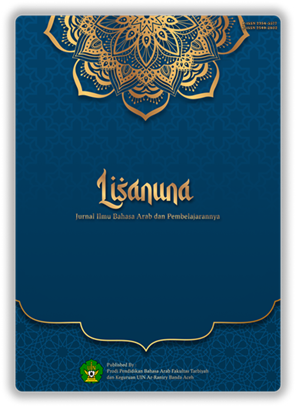" by Nizar Qabbani "سأقول لك أحبك Structure Analysis in The Poem تحليل البنية في قصيدة "سأقول لك أحبك" لنزار قباني
DOI:
https://doi.org/10.22373/ls.v13i1.18029Keywords:
analysis, structure, poem I will tell you I love you, Nizar Qabbani.Abstract
Each literary work must contain the internal elements, writing cannot be called a literary work, because these elements are important in the formation of the literary work. In this poem expresses the feelings of the poet through his elements. Therefore, it is necessary to understand the elements of poetry in it, because knowledge of the analysis of the structure is the elements of the interior, using the theory of the analysis of the structure of this poem. One of the literary works is the poem "I will tell you I love you", a kind of literary genre in which the poet depicts his experience in balanced words. As for the research method used in writing this research, it is the descriptive analytical method, as it describes and analyzes the poem with the theory of structure with its elements. To collect information and data related to this research, we rely on the library method. By reviewing the literary and linguistic scientific books related to this research. Among the results reached by the researcher is that the structure in the poem is four, namely, the subject is the love of women, the emotion is longing, happiness, and fear, and the imagination that the poet depicts is the graphic imagination, the compositional imagination, and the style.
References
Herman, J. W. (1987). Teori dan Apresiasi Puisi. Erlangga.
Nurgiyantoro, B. (1994). Teori Pengkajian Fiksi. Gadjah Mada University Press.
إبراهيم أنيس. (2008). المعجم الوسيط. مكتبة الشروق الدولية.
الزروق عبد الحميد علي. (2019). نوازع الشوق والحينين لدى شعراء المهجر إيليا أبو ماضي نموذجا درسة ادبية. مجلة الأ كايمية, 2(1), 6.
الطيب دبة. (2020). المبادئ اللسانية البنيوية، دارسة تحليلية ابستمولوجية لطلبة. معاهد اللغة العربية والباحثين في الدراسات اللسانية الحديثة, 119.
جان بياجيه. (1945). اللبنية وخصائصها. منشورات عويدات بيرت.
جبّور عبد النّور. (1979). المعجم الأدبي. دار العلم للملليين.
حمدي السكوت. (1970). قاموس الأدب العربي الحديث. الهيئة المصرية العامة للكتاب.
خليف جاسم السلطاني. (2014). الأدب العربي الحديث مختارات من الشعر والنثر. دار الرضوان للنشر والتوزيع.
صالح بن رشيد العضياني. (2021). البنيوية من النشأة والمهفوم إلى التوظيف والتكوين. مجلة العلم اللغوية والأدب, المجلد ۱، العدد ۱.
صالح غانم راشد مصاروة. (2019). تجليات بنيوية في قصيدة البردة للشاعر تميم البرغوثي. برنامج اللغة العربية وآدابها، كلية الدراسات العليا، جامعة القدس المفتوحة, 2(2), 6.
عبدالسلام المسدي. (1991). قضيّة البنيوية دراست ونماذج. دار أمية.
قائم الدين. (2019). رؤية عالم الكاتب في شعر “في الشعر” لنزار قباني (دراسة تحليلة بنيوية تكوينية عند نظرية لوسيان غولدمان).
محمد التونجي. (1999). المعجم المفصل في الأدب (2nd ed.). دار الكتب العلمية.
محمد رضوان. (2005). أروع ما كتب نزار قبانى شهريار هذا الزمان. دار الكتاب العربي.
نزار قباني. (2000, November 12). البطاقة الشخضية. الكتروني : موقع الشاعر صالح زيادنة.
هاشم شريف. (2016). نزار قباني شاعر المرأة والوطن. قسم اللغة والأدب العربي، جامعة آبي بكر بلقايد.
هالة العبوش. (2016). دراسة أسلوبية في شعر الحب عند نزار قباني. جامعة فيلادلفيا, 2(2), 117.
Downloads
Published
Issue
Section
License
1. Proposed Policy for Journals That Offer Open Access Authors who publish with this journal agree to the following terms:
1.a. Authors retain copyright and grant the journal right of first publication with the work simultaneously licensed under a Creative Commons Attribution License that allows others to share the work with an acknowledgement of the work's authorship and initial publication in this journal.
1.b. Authors are able to enter into separate, additional contractual arrangements for the non-exclusive distribution of the journal's published version of the work (e.g., post it to an institutional repository or publish it in a book), with an acknowledgement of its initial publication in this journal.
1.c. Authors are permitted and encouraged to post their work online (e.g., in institutional repositories or on their website) prior to and during the submission process, as it can lead to productive exchanges, as well as earlier and greater citation of published work (See The Effect of Open Access).
2. Proposed Policy for Journals That Offer Delayed Open Access Authors who publish with this journal agree to the following terms:
2.a. Authors retain copyright and grant the journal right of first publication, with the work [SPECIFY PERIOD OF TIME] after publication simultaneously licensed under a Creative Commons Attribution License that allows others to share the work with an acknowledgement of the work's authorship and initial publication in this journal.
2.b. Authors are able to enter into separate, additional contractual arrangements for the non-exclusive distribution of the journal's published version of the work (e.g., post it to an institutional repository or publish it in a book), with an acknowledgement of its initial publication in this journal.
2.c. Authors are permitted and encouraged to post their work online (e.g., in institutional repositories or on their website) prior to and during the submission process, as it can lead to productive exchanges, as well as earlier and greater citation of published work (See The Effect of Open Access).

